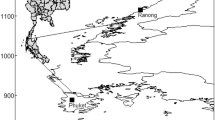Abstract
The persistent ultra-high temperature caused by global warming effect has sounded the alarm for the development of human society. In order to improve these problems and make some constructive suggestions, this paper focuses on the main factors affecting global temperature using time series and GA-BP neural network prediction models to investigate the trend of global average temperature. We first preprocess the data using mean interpolation, and then compare the significance of the global mean temperature change using Kruskal–Wallis test with multiple independent samples concluding that the global temperature increase triggered by March 2022 does not exceed the temperature of the past decade. Then, using a time-series prediction model and a GA-BP neural network, temperatures in 2050 are predicted to be 15.275, 14.863 and 14.862,15.660, and 15.204, 15.178, based on global average annual temperature data from previous years and taking into account various factors such as carbon dioxide, solar radiation intensity and fossil fuel combustion. The above model shows that the predicted temperatures reach 20 °C only at 2758, 2912 and 2860, which implies that the global average temperature will not reach 20 °C from 2050 to 2100. Finally, we compare the performance of the above models by determining the coefficients and find that the prediction based on the GA-BP neural network which is the most accurate.
Access this chapter
Tax calculation will be finalised at checkout
Purchases are for personal use only
Similar content being viewed by others
References
Yang, H., Li, X., Qiang, W., Zhao, Y., Zhang, W., Tang, C.: A network traffic forecasting method based on SA optimized ARIMA–BP neural network. Comput. Netw.. Netw. 193, 108102 (2021)
Abhishek, K., Misra, B.B.: Hybrid genetic algorithm and time delay neural network model for forecasting traffic flow. In: 2016 IEEE International Conference on Engineering and Technology (ICETECH), IEEE, pp. 178–183 (2016)
Deng, Y., Weng, Z., Zhang, T.: Metaverse-driven remote management solution for scene-based energy storage power stations. Evol. Intell. 1–12 (2022)
Ma, X., Jin, Y., Dong, Q.: A generalized dynamic fuzzy neural network based on singular spectrum analysis optimized by brain storm optimization for short-term wind speed forecasting. Appl. Soft Comput.Comput. 54, 296–312 (2017)
Guo, N., Wang, Z.: A combined model based on sparrow search optimized BP neural network and Markov chain for precipitation prediction in Zhengzhou City, China. AQUA—Water Infrastructure. Ecosyst. Soc. 71(6), 782–800 (2022)
Qian, Z., Pei, Y., Zareipour, H., Chen, N.: A review and discussion of decomposition-based hybrid models for wind energy forecasting applications. Appl. Energy 235, 939–953 (2019)
Zhang, H., Tian, Z.: Failure analysis of corroded high-strength pipeline subject to hydrogen damage based on FEM and GA-BP neural network. Int. J. Hydrogen Energy 47(7), 4741–4758 (2022)
Xie, Y., Ishida, Y., Hu, J., Mochida, A.: A backpropagation neural network improved by a genetic algorithm for predicting the mean radiant temperature around buildings within the long-term period of the near future. In: Building Simulation, Vol. 15, pp. 473–492 (2022)
Jiang, P., Ma, X.: A hybrid forecasting approach applied in the electrical power system based on data preprocessing, optimization and artificial intelligence algorithms. Appl. Math. Model. 40(23–24), 10631–10649 (2016)
Li, Z., Piao, W., Wang, L., Wang, X., Fu, R., Fang, Y.: China coastal bulk (Coal) freight index forecasting based on an integrated model combining ARMA, GM and BP model optimized by GA. Electronics 11(17), 2732 (2022)
Wang, L., Zhan, L., Li, R.: Prediction of the energy demand trend in middle Africa—a comparison of MGM, MECM ARIMA and BP models. Sustainability 11(8), 2436 (2019)
Xiao, L., Shao, W., Yu, M., Ma, J., Jin, C.: Research and application of a hybrid wavelet neural network model with the improved cuckoo search algorithm for electrical power system forecasting. Appl. Energy 198, 203–222 (2017)
Zheng, D., Semero, Y.K., Zhang, J., Wei, D.: Short-term wind power prediction in microgrids using a hybrid approach integrating genetic algorithm, particle swarm optimization, and adaptive neuro-fuzzy inference systems. IEEJ Trans. Electr. Electron. Eng.Electr. Electron. Eng. 13(11), 1561–1567 (2018)
Hua, L.: Power quality prediction of active distribution network based on CNN-LSTM deep learning model. In: Artificial Intelligence for Communications and Networks: Third EAI International Conference, AICON 2021, Xining, China, October 23–24, 2021, Proceedings, Part I 3, pp. 108–122 (2021)
Zheng, W., Peng, X., Lu, D., Zhang, D., Liu, Y., Lin, Z., Lin, L.: Composite quantile regression extreme learning machine with feature selection for short-term wind speed forecasting: a new approach. Energy Convers. Manage. 151, 737–752 (2017)
Author information
Authors and Affiliations
Corresponding author
Editor information
Editors and Affiliations
Rights and permissions
Copyright information
© 2024 The Author(s), under exclusive license to Springer Nature Singapore Pte Ltd.
About this paper
Cite this paper
Wang, T., Jiang, Y., Liu, M. (2024). Exploration of Future Temperature Analysis Based on ARIMA Time Series Model and GA-BP Neural Network Prediction Model. In: Kountchev, R., Patnaik, S., Wang, W., Kountcheva, R. (eds) Multidimensional Signals, Augmented Reality and Information Technologies. WCI3DT 2023. Smart Innovation, Systems and Technologies, vol 374. Springer, Singapore. https://doi.org/10.1007/978-981-99-7011-7_25
Download citation
DOI: https://doi.org/10.1007/978-981-99-7011-7_25
Published:
Publisher Name: Springer, Singapore
Print ISBN: 978-981-99-7010-0
Online ISBN: 978-981-99-7011-7
eBook Packages: Intelligent Technologies and RoboticsIntelligent Technologies and Robotics (R0)




